Basel, Switzerland: A delightful and surprising trip to see the Basel sights
We’re the only passengers, and once we’ve boarded the boat, the ferryman walks forward and grabs a large lever. He yanks at it, neatly moving it from the left to the right side of the boat. He returns to the stern and sits down on a bench. Gently, barely noticeably at first, we begin to move. We shift into the river’s current, which is running quite fast after recent floods. The boat points into the current, yet glides smoothly sideways until we very gently nudge the dock on the opposite bank.
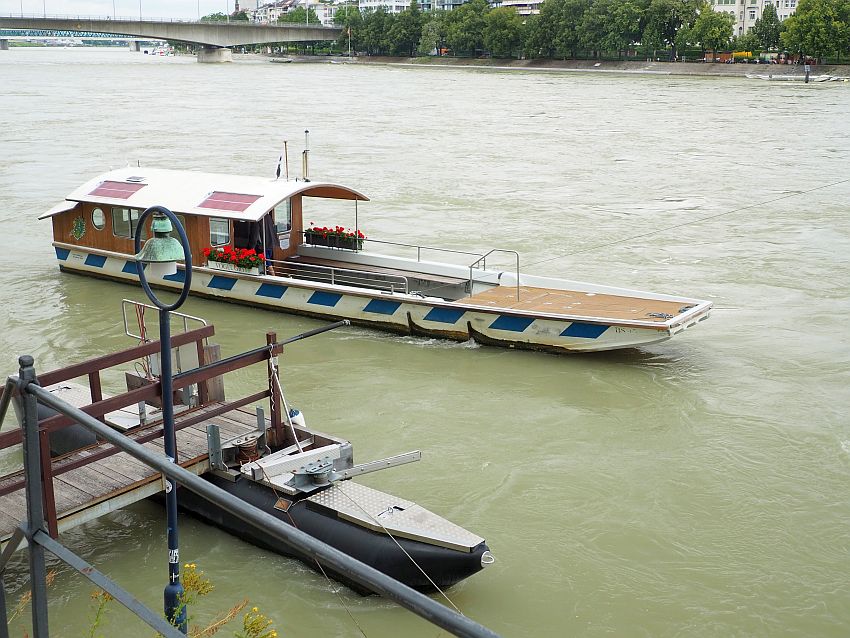
This is one of the many delightful surprises we experienced during our visit to Basel, Switzerland. Why cross a river using a bridge – that’s so mundane! – when you can drift across in a motorless, sail-less boat?
Disclosure: Our visit to Basel was sponsored by Basel Tourism, which provided us with help in planning our visit, a private walking tour, and meal vouchers. They have no influence over what I write. In addition, the Fondation Beyeler provided us with free admission.
Another disclosure: This article contains affiliate links. If you click on one and make a purchase, I will receive a small commission. This will not affect your price.
Reaction ferries
Four of these little “reaction ferries” cross the Rhine in Basel, connecting the two halves of the city. How do they work? Each is attached by a slender cable to a larger cable that spans the river. If you look very carefully at the photo above, you can see the cable at the bow of the boat. The lever that the boatman controls sets tillers under the water. That’s all that’s needed: the river’s current, pushing those tillers, shifts the boat sideways. Set the tillers the other way, and the boat crosses back.
Reaction Ferries: Ferries leave from four different points along the river, shown on any tourist map. CHF 1.60 children CHF 0.80.
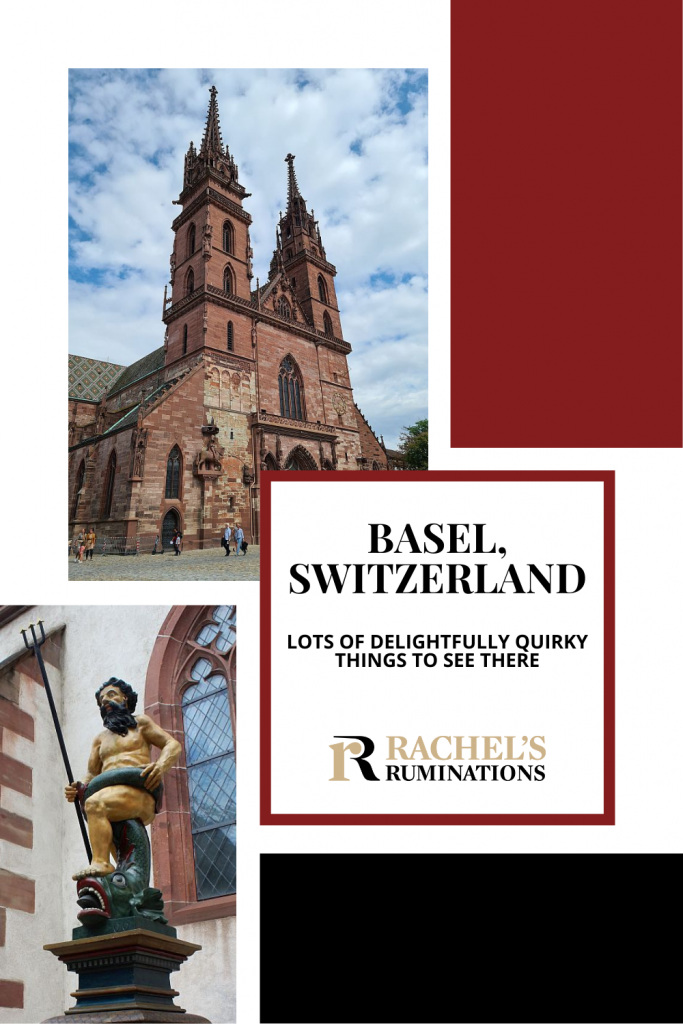
Tinguely sights
Another surprising Basel sight waiting for us was the Tinguely fountain. Designed by Jean Tinguely (1925-1991), using bits of old equipment from a theater that used to occupy the Theaterplatz, the fountain moves in all sorts of entertaining ways. A face spews water from its eyes as it rocks back and forth. A contraption seems to step in the water, scooping water and splashing it back. Who would have thought a fountain could make one laugh out loud?
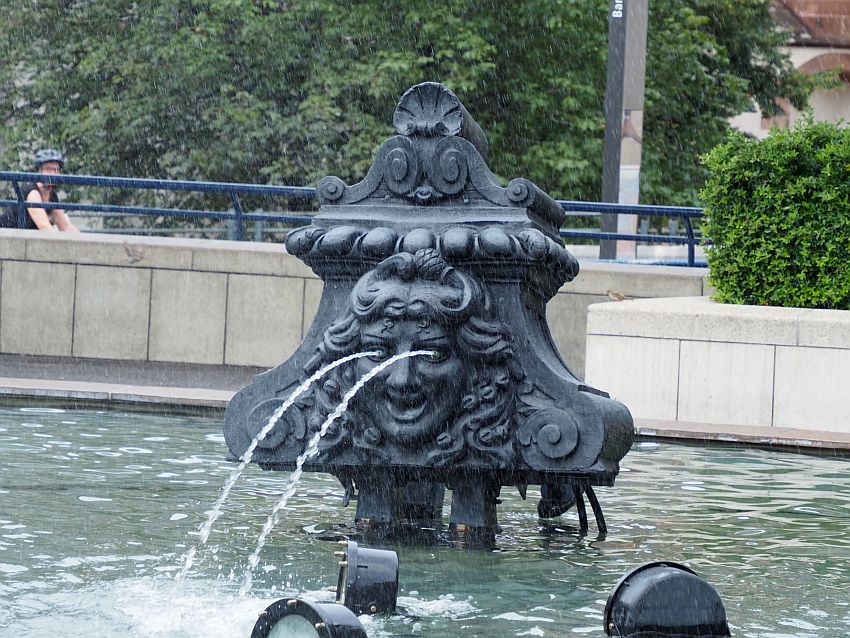
Tinguely Fountain: Between Theater-Passage and Klostergasse.
We didn’t get a chance to see it, but there’s also a Tinguely Museum. If this fountain is any indication, the kinetic creations in the museum must be great fun!
Museum Tinguely: Paul Sacher-Anlage 2. Open Tuesday-Sunday 11:00-18:00. Admission Adults CHF 18, children under 16 free. Half-price with BaselCard. Website.
Basel Cathedral
More delights awaited us at the Basel Münster (Cathedral). The red sandstone structure partly dates to a 12th and 13th-century Romanesque cathedral, and partly to its 15th-century reconstruction in gothic style after an earthquake in 1356.
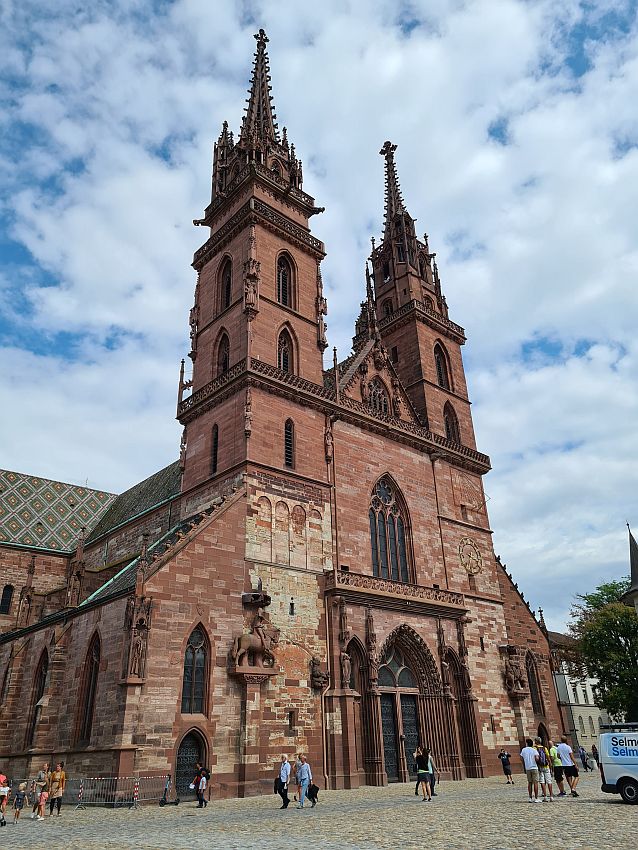
What drew our attention immediately were the two charming statues flanking the cathedral’s entrance. One depicts St. Martin, the saint who cut off his cloak to give to a beggar. In this statue, he is busy cutting his cloak, but there’s no beggar in sight!
Even more amusing is the statue to the left. It depicts St. George slaying the dragon. He’s on a horse and carries a very long lance … but the dragon is only the size of a large dog! It’s so cute, too, that it’s hard to see why St. George would feel the need to kill it!
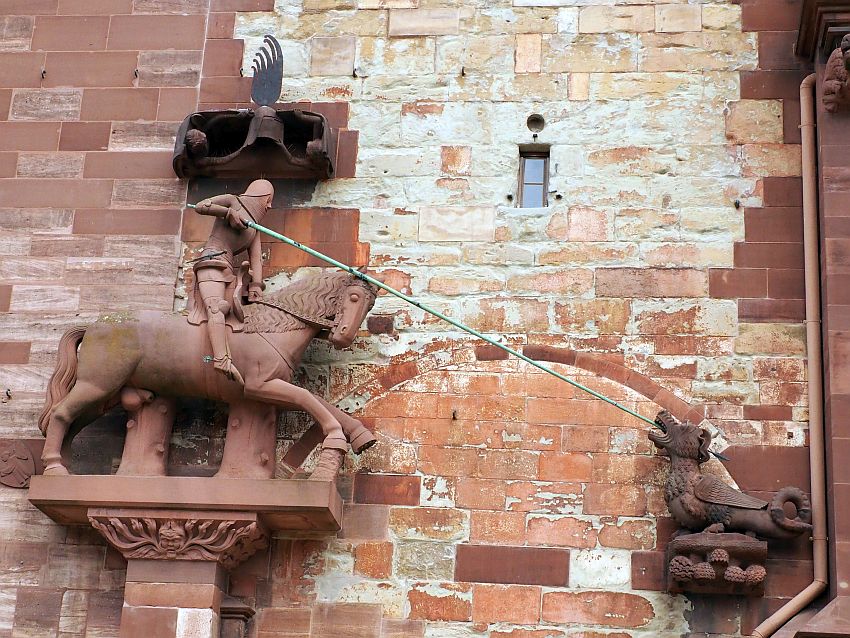
Inside, wandering the ancient and quiet interior, lit mostly through stained-glass windows, we came upon a tomb from the 14th century. A beam of sunlight illuminated it from above. Was it planned this way all those centuries ago?
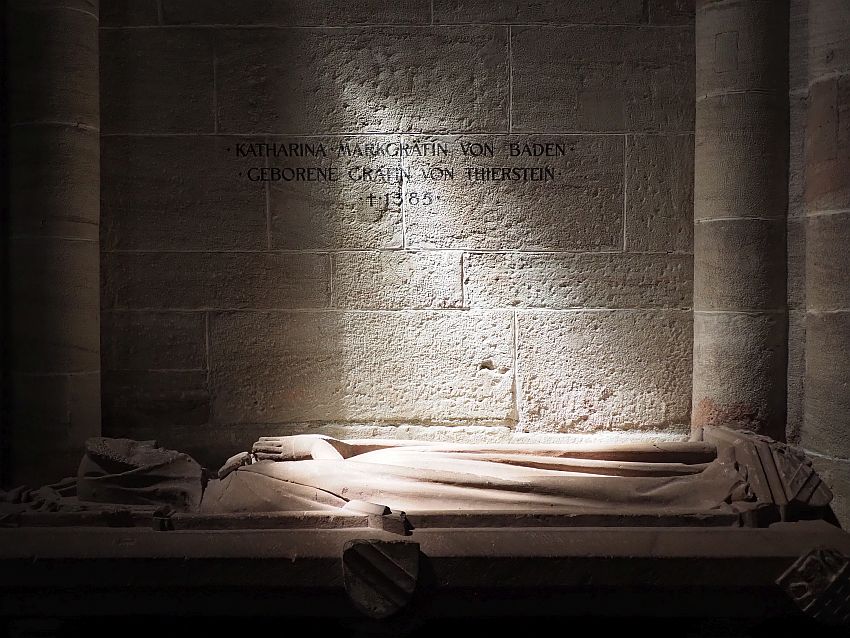
We touched on Erasmus’s life in Freibourg when we saw a house he lived in there. Here in the cathedral, we came upon Erasmus’s tomb, or rather a carved panel on the wall stating that he was buried there. Given that he was a Dutch man from Rotterdam, both were a surprise to us.
Have you ever noticed how ancient cloisters immediately give you a feeling of rest and reverence? That’s true here too, where the cloister is attached to Basel Cathedral, right in the middle of a city.

After the somber inspection of the interior, we climbed one of the cathedral’s two spires – both can be climbed. The narrow stairways (about 250 steps) and even narrower walkways on the spire made me distinctly nervous, but the views over the city were worth it.
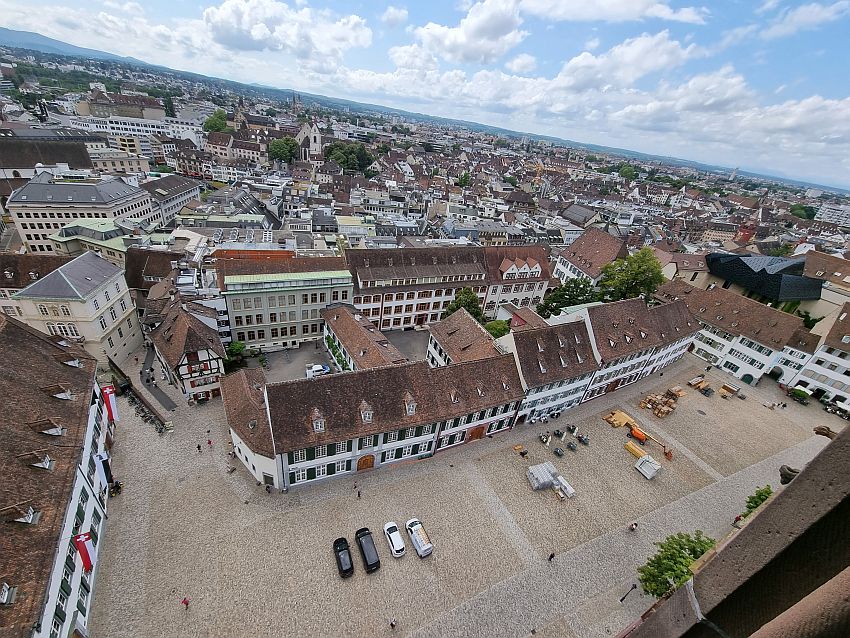
Basel Cathedral: Münsterplatz. Open during the summer Monday-Friday 10:00-17:00, Saturday 10:00-16:00 and Sunday 11:30-17:00. During the winter, Monday-Saturday 11:00-16:00 and Sunday 11:30-16:00. The towers have the same hours except that they are closed during midday prayers from 12:00-12:20. The cloister is open daily 8:00 until dark. The crypt is only viewable in the summer months. Fee for tower climb: Adults CHF 6, children under 14 free.
Kunstmuseum
Walking from the Basel Cathedral along the Rittergasse – a lovely street lined with tidy rows of historic houses – we were a bit taken aback at seeing what looked like a big blank wall blocking the end of the road in the distance. I thought it was horrible, like some sort of alien wall in a sci-fi movie, plunked down at the end of a street. As we neared it, we realized it was a separate building in a very modern style: minimalist and grey.
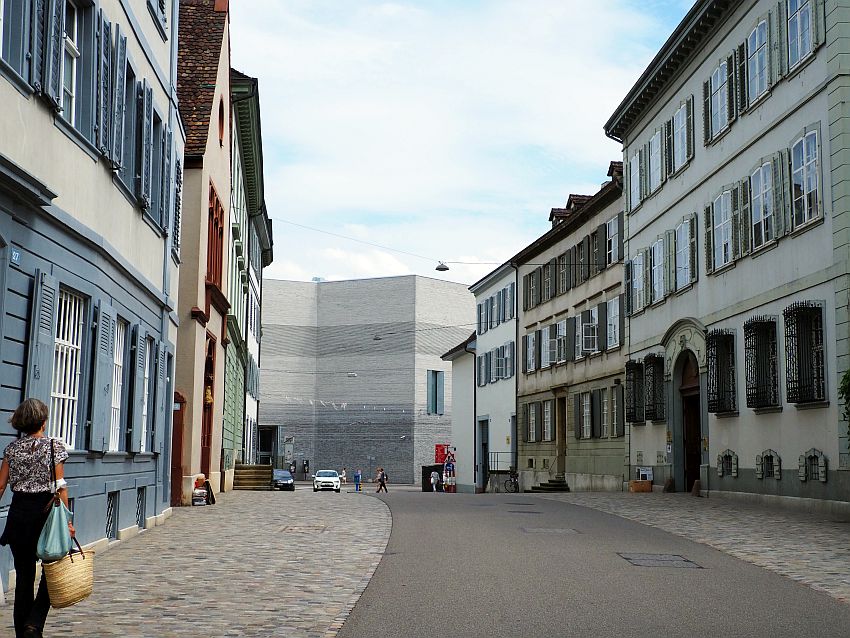
Our tour guide explained that this structure is an expansion of the older Kunstmuseum (Art Museum), founded back in 1661. The original building is so well-designed that the idea was to keep the new building plain so as not to compete with the old. That way the old building would remain the focal point. The art museum is huge and exhibits centuries of artworks, with the newest pieces in the new building.
Kunstmuseum: St. Alban-Graban 8. Open Tuesday-Sunday 10:00-18:00 and on Wednesday evenings until 20:00. Free on Tuesday-Friday after 17:00 and on the first Sunday of the month. Website.
Wandering the streets of Basel, Switzerland
Wandering the streets of the old part of Basel south of the river was a delight as well. With its narrow streets – sometimes mere stairways – cobbled sidewalks and historic buildings, it just oozes charm, yet the modern is never far away: clean streets, a modern tram system, excellent restaurants and chic shops.
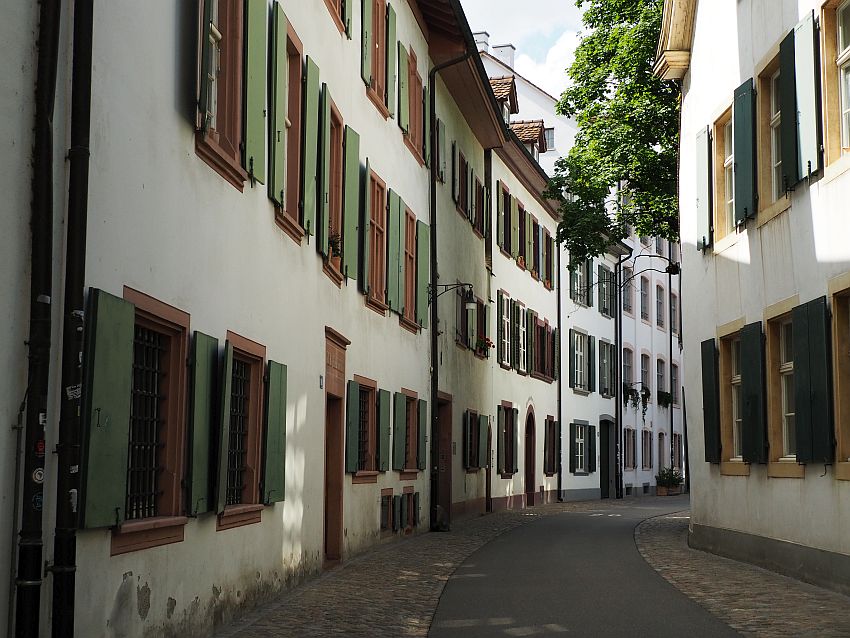
The architectural styles we spotted as we walked ranged from gothic – mostly churches and monasteries – to very sober and plain white plastered houses, to charming half-timbered houses, to positively baroque creations like the Rathaus (City Hall) on Marktplatz.
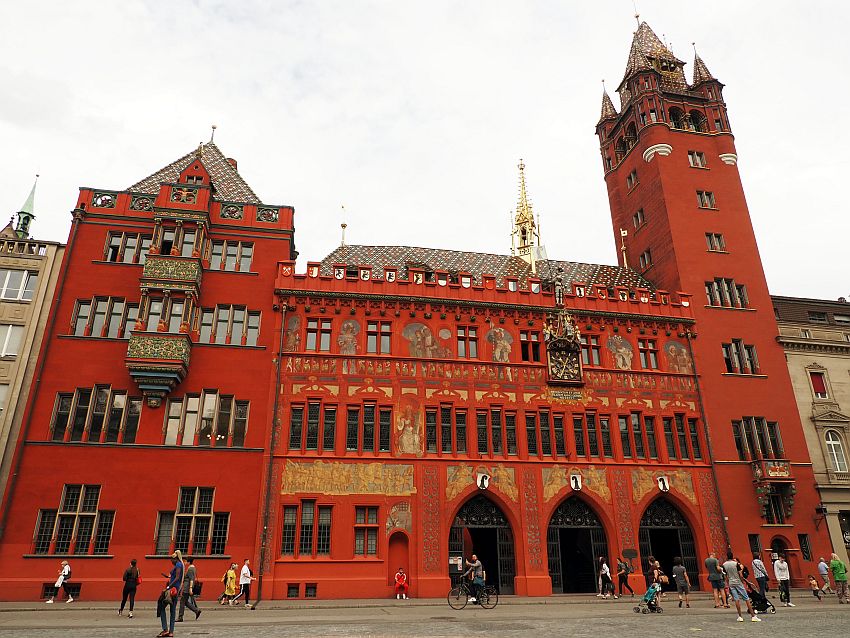
Some of the older houses have painted flourishes around their windows. At one point I wandered into an open entryway that led into what appeared to have once been a monastery cloister. At the end of the passageway, I came to a place where I could see across to a neighboring building with elegant decorations around its window and a fanciful fish adorning its drainpipes. You’ll spot quirky touches like this everywhere in the old city if you keep your eyes open.
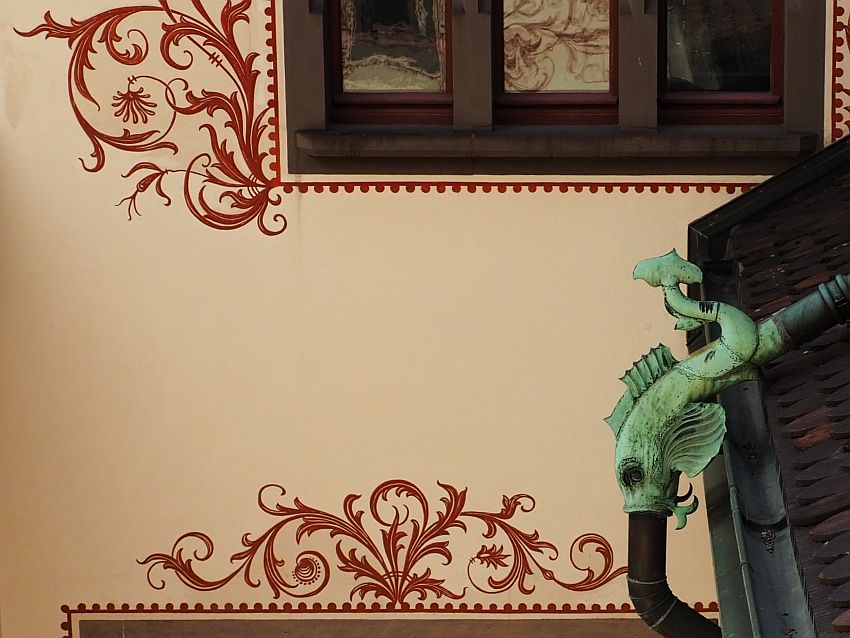
Elisabethenkirche
We passed Elisabethenkirche (Elizabeth Church), a 19th-century gothic revival church. It is home to an “Open Church” which caters to everybody of any faith. It is used as a counselling center, event hall and concert hall, and the rainbow-colored banner across its entrance, when we visited, proudly proclaimed “Gott ist (jede) Liebe” [God is (every) love], followed by “LGBTQI welcome in this church.”
Elisabethenkirche: Elisabethenstrasse 10-14. Open Monday-Saturday 10:00-19:00 and Sunday 12:00-19:00. Website.
Basel sights: city gates
Three of Basel’s city gates remain from its original fortifications, all dating to about 1400. Spalentor is the most impressive, with its decorative roof tiles and the two round towers that flank it. St. Johanns-tor is simpler: a square tower of stone and white plaster. St. Albantor is similar: a square, simple tower, but with one projecting window near the top.
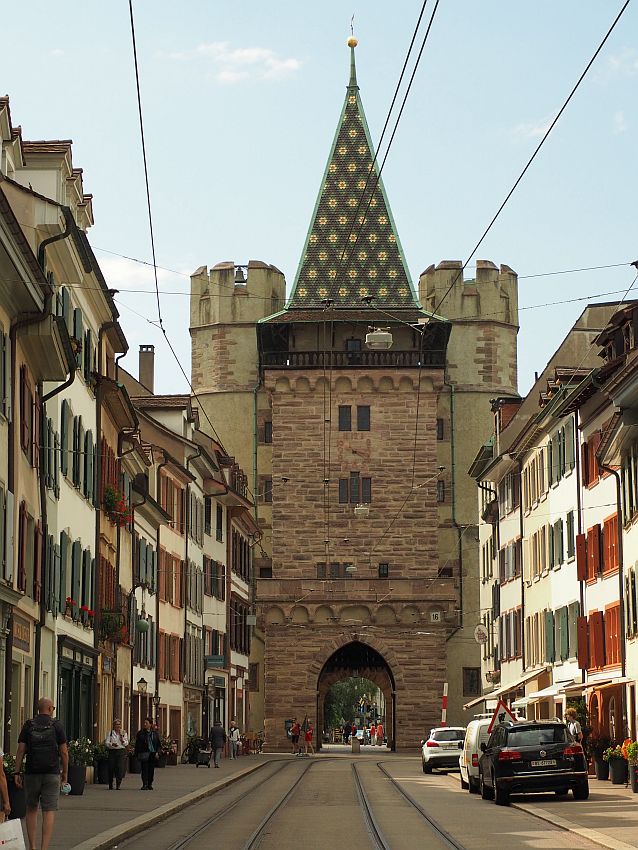
Spalentor: Spalenvorstadt. St. Johanns-tor: St. Johanns-Vorstadt. St. Albantor: St. Alban-Vorstadt.
Hoosesaggmuseum
We never would have noticed it without our tour guide, provided to us by Basel Tourism: a quirky little “museum” called Hoosesaggmuseum. It’s a “pocket” museum, meaning it’s extremely small. In fact, the whole museum is a window in the door of a small house in a narrow alley. Whoever lives there has lots of collections of very small items. Every couple of months, she puts another set into the display window. When we were there, the window showed a collection of small pins and ribbons – the kind that stores often give away for free – in a patriotic theme.
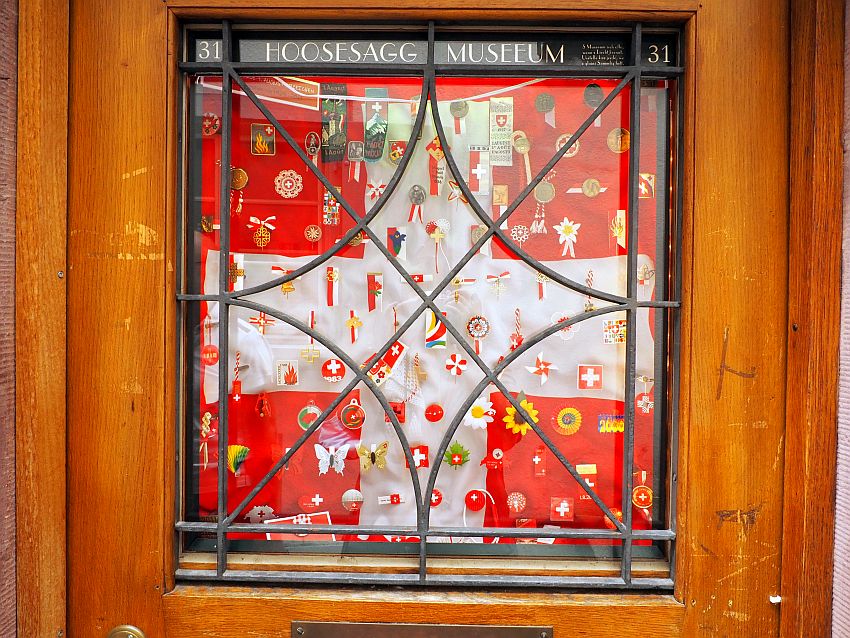
The advantage of the entire exhibit being in a street-facing window is that it’s always open!
Hoosesaggmuseum: Imbergässlein 31.
Street art
There’s plenty of street art, as well, so keep your eyes open. Check out the sculpture by Picasso, for example, on Picassoplatz (where Dufourstrasse meets Lautengartenstrasse), or a dragon sculpture by Tomas Schütte, complete with smoke coming out its nose, at Aeschengraben 31 where it meets Nauenstrasse.
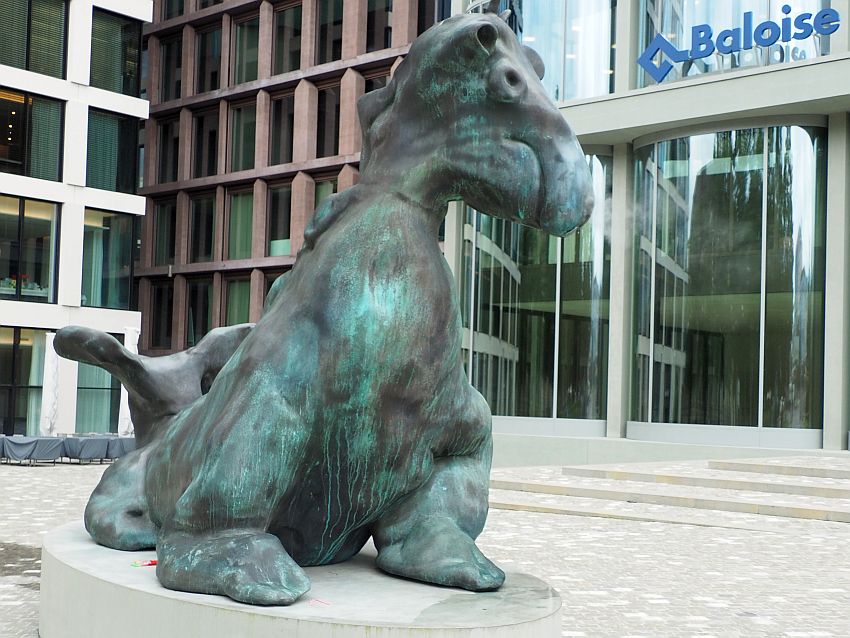
Not all street art is new, of course, and often the earlier embellishments are quite funny. Take, for example, the odd-looking lions on the zur Mücke building at Schlüsselbergstraße 14. The local nobility used to meet here in the Middle Ages and have grand feasts.
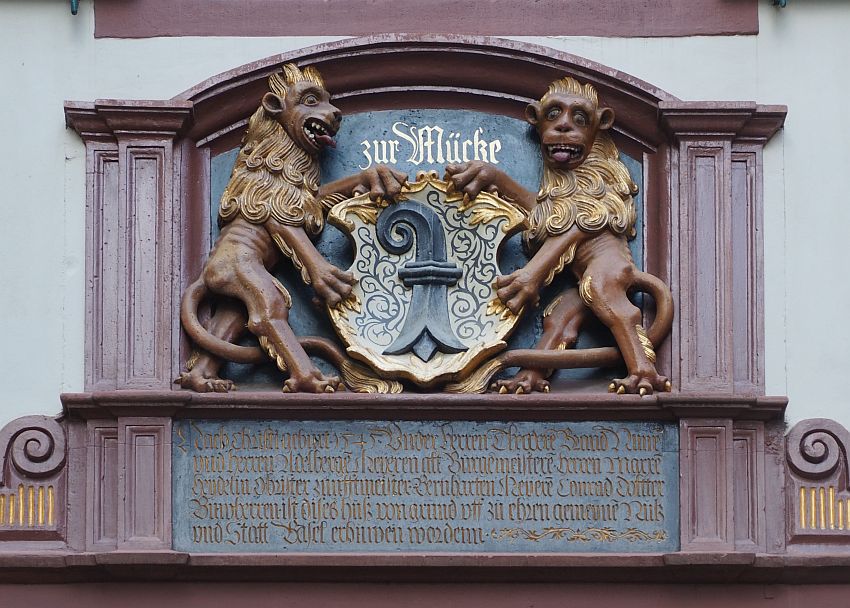
I already mentioned the Rathaus (city hall) on Marktplatz above. If you see it, check out the detail sculptures on the ornate facade.
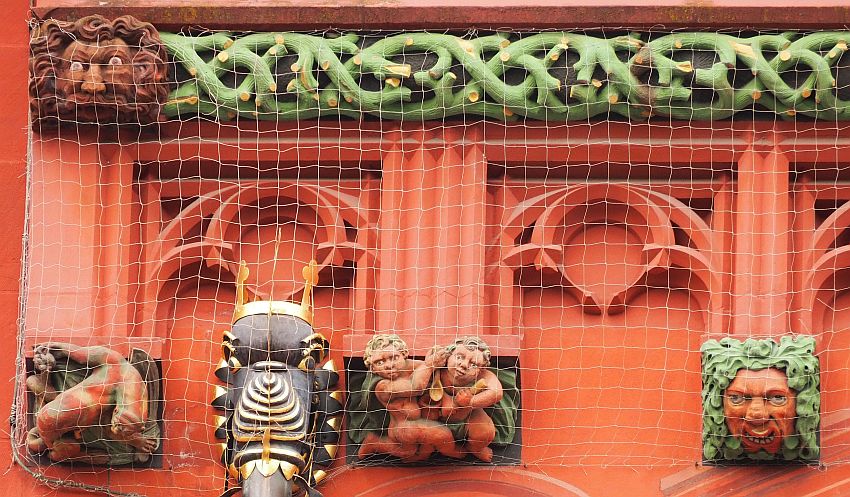
Also, make sure to notice the fountains you’ll come upon here and there: this cute statue of Poseidon from 1706 tops a fountain with a very expressive face.
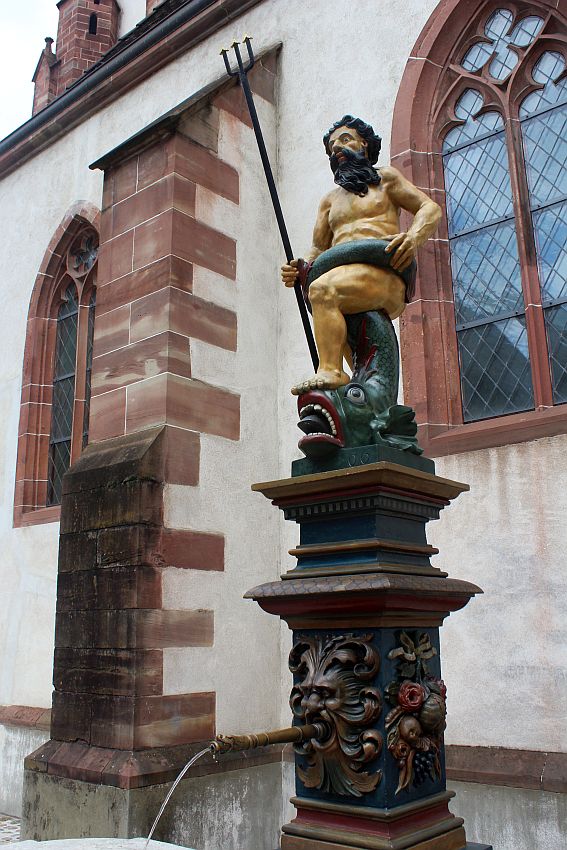
We liked this one too, with a bagpiper on the top. Below, a series of figures dance to the bagpipe’s tune, circling the column he stands on.
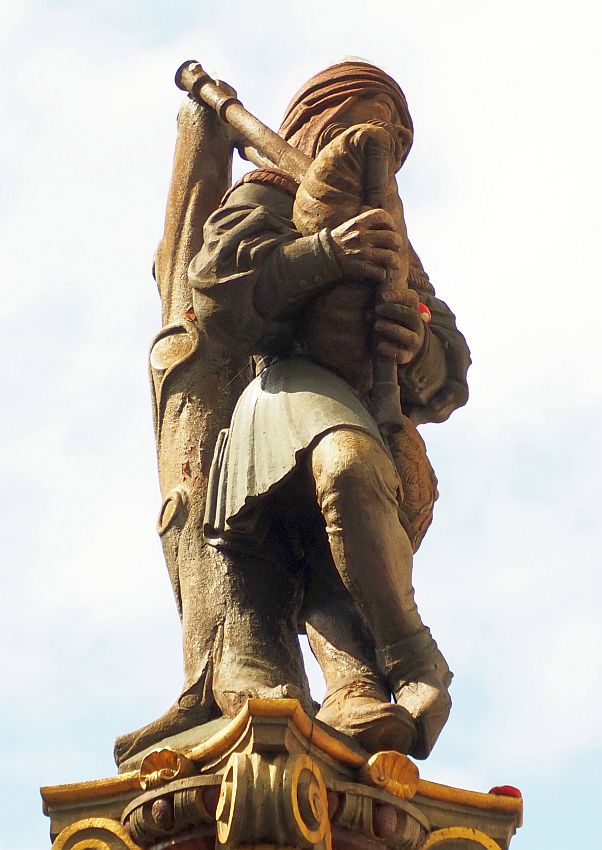
Fondation Beyeler
Probably the most surprising experience from our short time in Basel was the Fondation Beyeler, a modern art museum. We knew nothing about it, and we went only because several people had urged us to do so. The Beyeler also sponsored us by providing our tickets.
Having said that, the Beyeler turned out to be one of the best museums I’ve ever been to. The quality of the artworks by world-renowned artists that they exhibit is astounding. You can read all about it in my separate post. The museum is outside of town but easy to get to by public transportation.
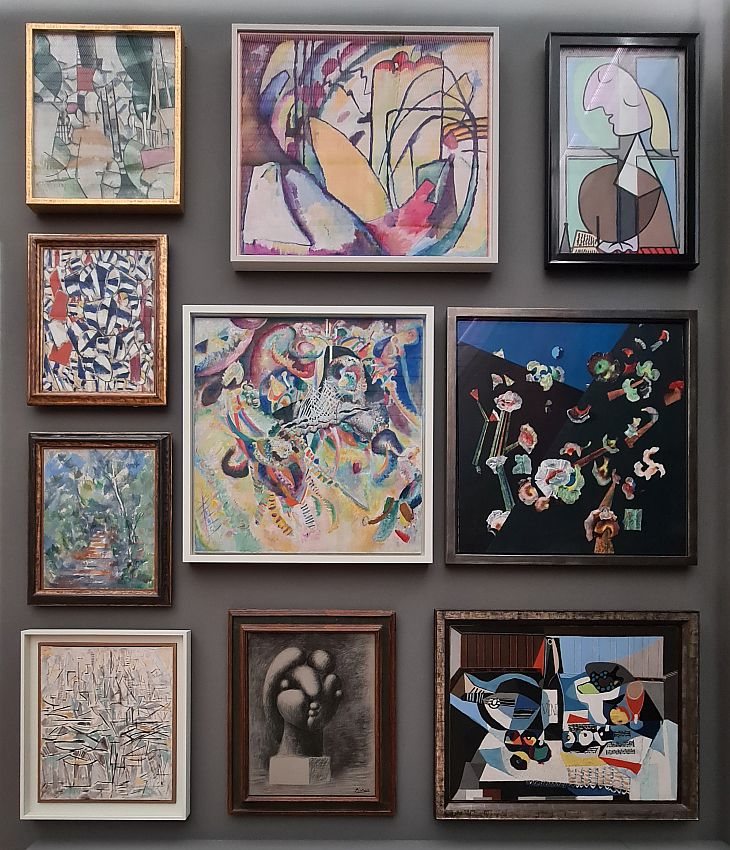
Fondation Beyeler: Baselstrasse 101, Riehen. From the main train station take Tram 2 towards Eglisee and get off at the stop called Basel, Badischer Bahnhof. Transfer to Tram 6 toward Riehen, Grenze. Get off at the Fondation Beyeler stop which is right in front of the entrance. The whole route takes about 25 minutes. Open daily 10:00-18:00 and on Wednesdays until 20:00. Admission: Adults CHF25, up to 25 years free. 50% off with BaselCard. Website.
Swimming in the Rhine
Here’s another quirky thing about Basel. On hot days in the summer, the residents of Basel go swimming in the river. That’s not so unusual, but the local way to do it is to use a wickelfisch, a waterproof sealable bag. You fill it with your clothes and whatever else you have with you, and leave some air in it as well, so it floats. Then you use it as a flotation device as you drift down the river in the current.
You can buy a wickelfisch at the Visitors Information Center at Barfüsserplatz, Steinenberg 14.
Where to stay in Basel, Switzerland
We stayed in a bright blue (again, surprising!) hotel called Grand Hotel Euler, which I would certainly recommend. Our room had lots of space and a big, spotlessly-clean and modern bathroom. I particularly liked having a proper full-size solid-wood desk instead of the usual narrow plank attached to the wall.
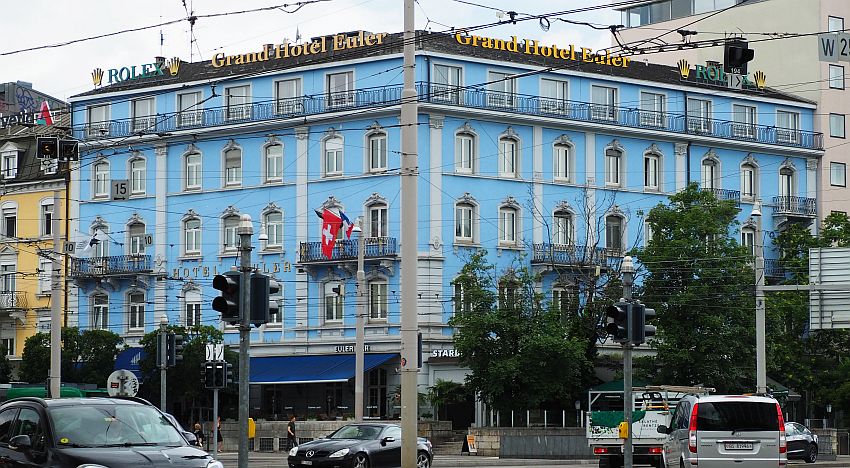
Our room overlooked a big intersection where lanes of car traffic and trams crossed, with the tram station on one side and a park on the other. Yet with the windows closed, all sound was blocked out and we slept very well. The hotel offers a continental breakfast, and I liked that we could eat outside when the weather was good.
Besides that the rooms are tastefully done and comfortable, this hotel has several special things going for it. The fact that it’s right next to the train and tram stations makes it particularly convenient. Even in our case, arriving by car rather than train, staying at that location made using public transportation to see the Basel sights a no-brainer: since many tram lines start and end at the train station, it was easy to know which ones to take to get to the hotel.
And speaking of arriving by car, the Hotel Euler also has a parking garage in its basement. It’s surely the smallest parking garage I’ve ever seen, with only a handful of spaces, but you can reserve a space. You have to pay extra for it, but it’s worth it not have to deal with a commercial garage further away.
Once we’d parked, we left the car there and used public transportation during our stay.
To see what other accommodations are available, just click on the map below:
Eating in Basel, Switzerland
We’re not foodies, but we appreciate good food. While we were only in Basel for two nights, I still want to point out two restaurants that we greatly enjoyed. A representative from Basel’s tourism board took us for a meal at Rubino, a Mediterranean restaurant where I had a delicious white tomato soup – leading to a whole discussion about how one makes tomato soup that has no tomatoes in it – and an excellent salmon with vegetables. Rubino emphasizes organic and locally-produced ingredients as much as possible. In the evening they do surprise menus where you only choose vegetarian, meat or fish and then how many courses you want.
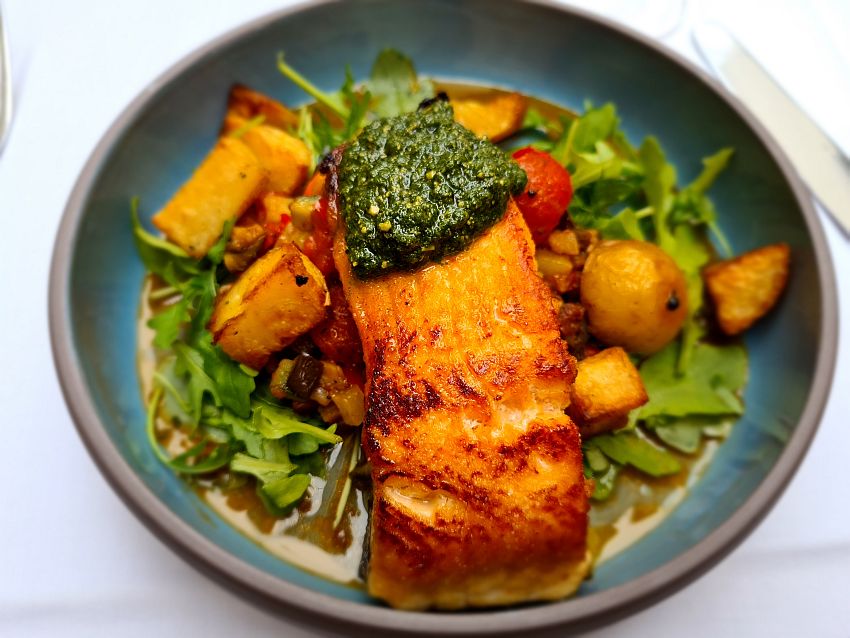
The second night we wandered into a restaurant called Kunsthalle, which offers German food, but with a bit of a twist. We ate outside in a pleasant quiet courtyard and I ordered a hamburger that somehow managed to be both chic and tasty, and much too big to eat with my hands. The fries are the thin “allumettes,” which I love.
Basel has lots of restaurants serving cuisine from all over the world. It boasts three Michelin-starred restaurants, including one that has three stars: Cheval Blanc. For a more homey (and less expensive) meal, try a traditional pub, many of which serve good, hearty food that’s not exorbitantly priced.
The local traditional sweet treat is called Basler Leckerly, baked in Basel for centuries. It’s a sort of small gingerbread biscuit with an airy texture and a sugar glaze. They’re a great gift to take home too; they can keep for a couple months if unopened.
BaselCard
All hotels in Basel will give you a free BaselCard when you check in. I wish more cities would do this! The card (which you can also use via an app on your phone) provides free use of public transportation and also 50% off admission to 23 different museums, including the ones I’ve mentioned above. It gives you access to guest wifi hotspots around the city as well as discounts on things like bike rentals, a bus tour, boat trips, the zoo, or a guided walking tour. Ask at your hotel for help with booking tours and finding their starting points.
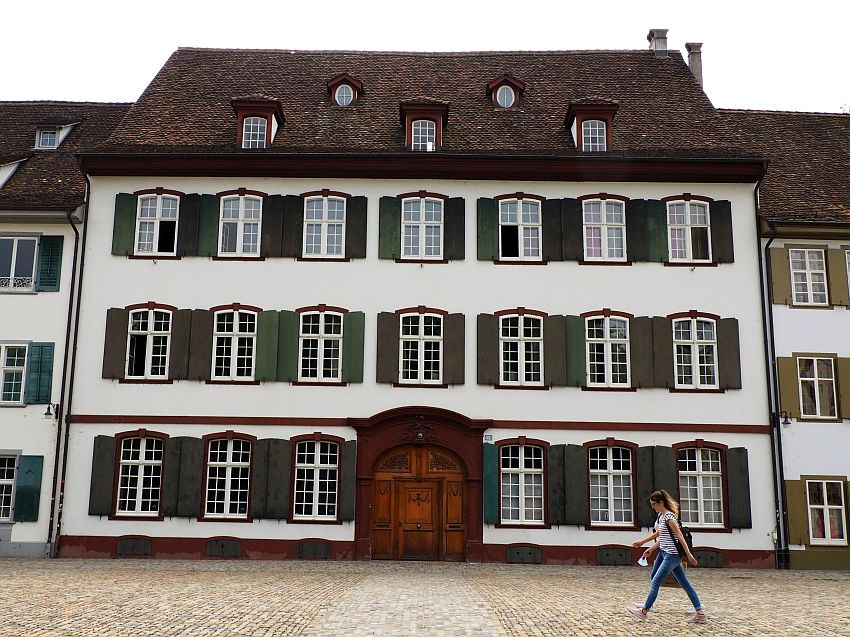
Where to find out about other things to see and do in Basel, Switzerland
There are lots more Basel sights besides the things I’ve mentioned here. For instance, the Basel Tourist Information’s “Basel Museums Guide” lists 34 museums, to be exact. You can pick up the guide at the Visitors Information Center at Barfüsserplatz, Steinenberg 14. Remember that your BaselCard gives you 50% off admission to many of them.
If you’re into architecture, the Visitor’s Information Center also has an excellent booklet about modern architecture, with three tours mapping out routes to see it all.
Another flyer you can pick up gives the routes for five different walking tours around Basel, if you prefer to wander at your own pace.
At this point I think you can see why I call Basel surprising and delightful and quirky: we found so much humor in so many of the Basel sights. If you’re planning a trip to southern Germany or to Switzerland, add Basel to your itinerary!
Have you been to Basel, Switzerland? Did you find it as enjoyable as we did?
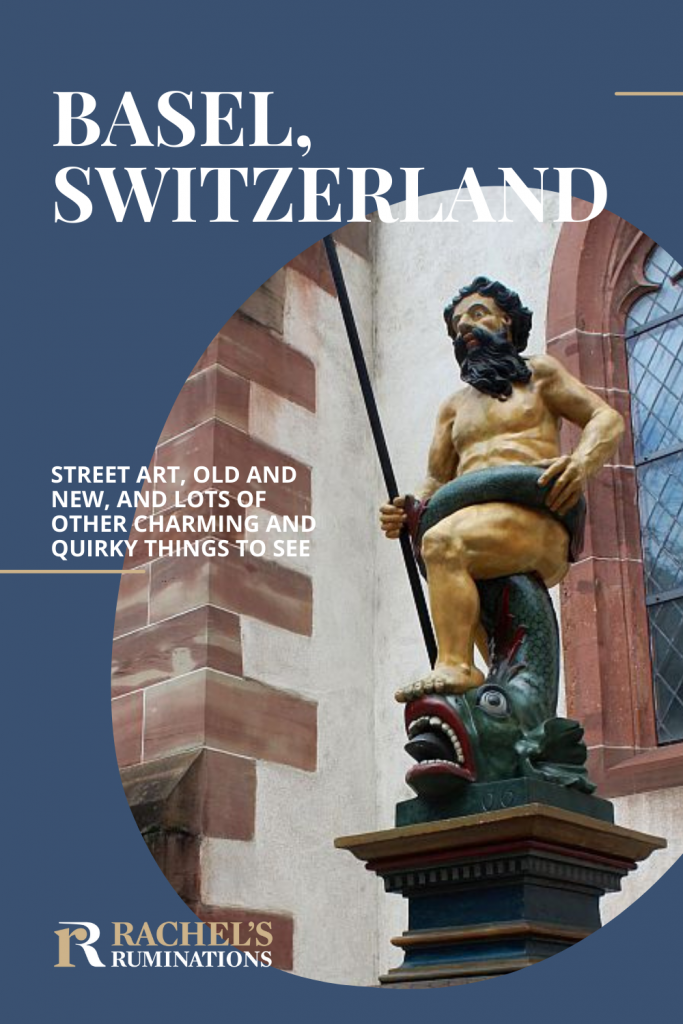


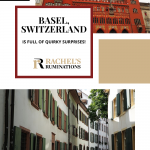
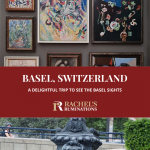
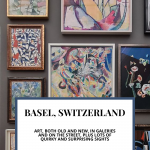
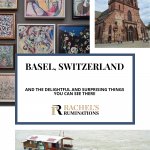

We love Basel and spent spent pleasant days there in early December a few years ago! The Christmas market was wonderful as well!